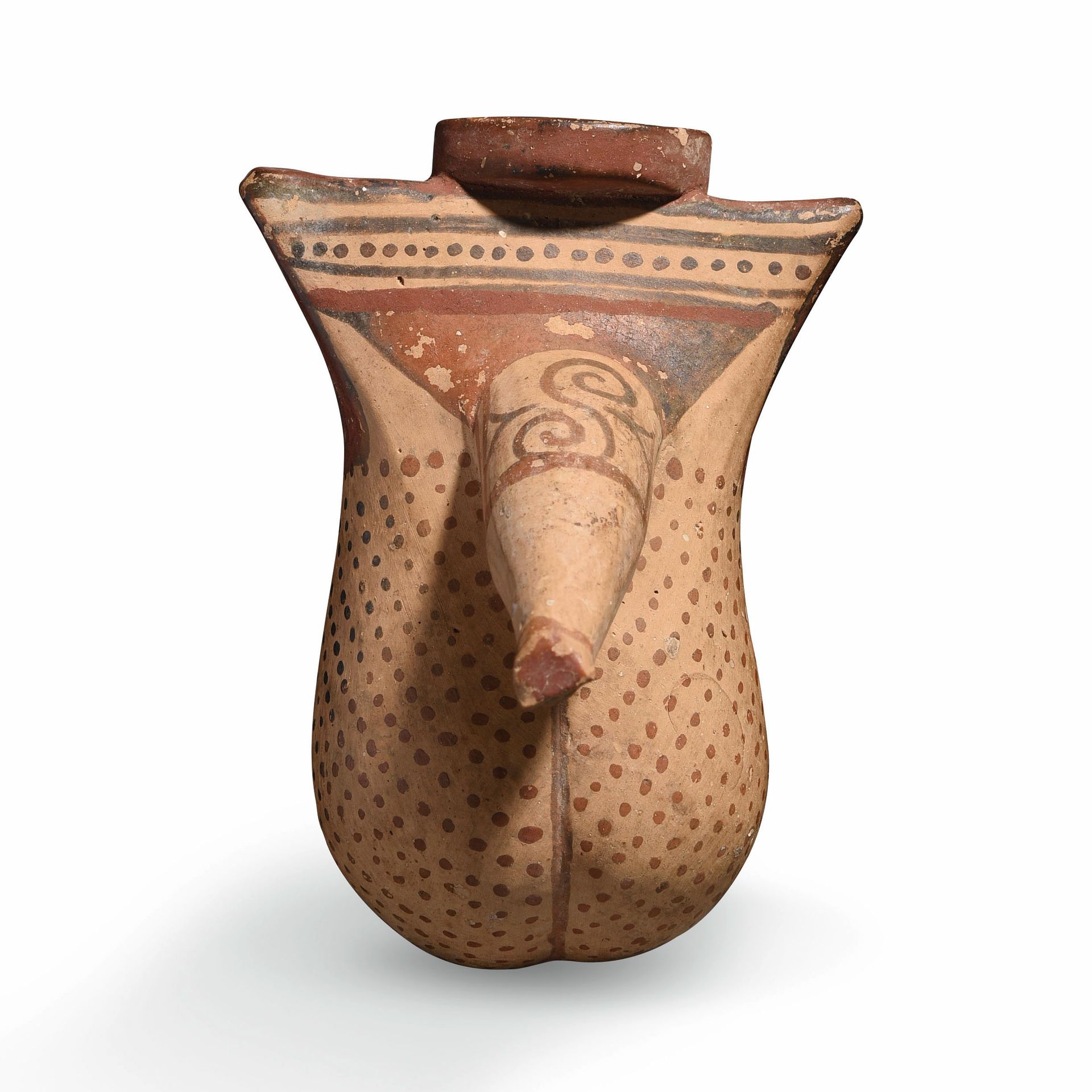Description
AIDOION IN THE FORM OF A PHALLUS Corinth, second quarter of the 6th century B.C. Terracotta and paint H : 7,6 cm Provenance Former private American collection, M. B., Colorado, acquired in the 1980s Private European collection The vase is hand-modeled in the shape of a male sex; a small, flat, circular neck is attached to the upper rim. The decoration, painted in reddish brown on a light clay background, abstractly reproduces (small dots, painted surfaces, straight lines) the hair of the pubic area. Like the aryballes or alabastres, the aidoion was a vase for perfume, often used as a gift in a sporting context. Complete, very well preserved; small chips, paint in places slightly chipped. See Metropolitan Museum, inv. 1999.78 The aidoion a rare cosmetic vase Phallus vases are a rare and distinctive feature of archaic Greek pottery. They were used to store scented oils, presumably of an erotic or medicinal nature. This vase is the product of an Eastern Greek workshop. Archaic Greek potters fashioned sculptural vases in a wide variety of forms, including human heads, legs and animals. This particular class reflects a recurring element of playfulness in Greek art. Bibliography Hemingway S., "Recent Acquisitions, A Selection: 1998-1999", Metropolitan Museum of Art, Bulletin Vol. 57, no.2, p. 7 ORTIZ g, The George Ortiz Collection: In Pursuit of the Anbsolute (Bern 1996), no.96. A Corinthian terracotta phallus-shaped aidoion. The vase is modeled by hand in the shape of a male; a small, circular, flat neck is attached to the upper edge. The decoration painted in red brown on the light clay background, reproduces in an abstract way (small dots, painted surfaces, straight lines) the hair of the pubic area. Like aryballs or alabasters, the aidoion was a perfume vase, mostly used often as a gift in sporting settings. Complete, very good conservation; small chips, paint in places slightly chipped. Phallus vases are a rare and distinctive feature of Archaic Greek pottery. They were used to store perfumed oils, presumably of an erotic or medicinal nature. This vase is the product of an East Greek workshop, probably on Rhodes. Archaic Greek potters fashioned sculptural vases in a wide variety of shapes, including human heads, legs, and animals. This particular class reflects an element of playfulness recurrent throughout Greek art. Bibliography Hemingway S., "Recent Acquisitions, A Selection: 1998-1999," Metropolitan Museum of Art, Bulletin Vol. 57, no. 2, p. 7ORTIZ g, The George Ortiz Collection: In Pursuit of the Anbsolute (Berne 1996), no.96. Ca. second quarter of the 6th century B.C.
82
AIDOION IN THE FORM OF A PHALLUS Corinth, second quarter of the 6th century B.C. Terracotta and paint H : 7,6 cm Provenance Former private American collection, M. B., Colorado, acquired in the 1980s Private European collection The vase is hand-modeled in the shape of a male sex; a small, flat, circular neck is attached to the upper rim. The decoration, painted in reddish brown on a light clay background, abstractly reproduces (small dots, painted surfaces, straight lines) the hair of the pubic area. Like the aryballes or alabastres, the aidoion was a vase for perfume, often used as a gift in a sporting context. Complete, very well preserved; small chips, paint in places slightly chipped. See Metropolitan Museum, inv. 1999.78 The aidoion a rare cosmetic vase Phallus vases are a rare and distinctive feature of archaic Greek pottery. They were used to store scented oils, presumably of an erotic or medicinal nature. This vase is the product of an Eastern Greek workshop. Archaic Greek potters fashioned sculptural vases in a wide variety of forms, including human heads, legs and animals. This particular class reflects a recurring element of playfulness in Greek art. Bibliography Hemingway S., "Recent Acquisitions, A Selection: 1998-1999", Metropolitan Museum of Art, Bulletin Vol. 57, no.2, p. 7 ORTIZ g, The George Ortiz Collection: In Pursuit of the Anbsolute (Bern 1996), no.96. A Corinthian terracotta phallus-shaped aidoion. The vase is modeled by hand in the shape of a male; a small, circular, flat neck is attached to the upper edge. The decoration painted in red brown on the light clay background, reproduces in an abstract way (small dots, painted surfaces, straight lines) the hair of the pubic area. Like aryballs or alabasters, the aidoion was a perfume vase, mostly used often as a gift in sporting settings. Complete, very good conservation; small chips, paint in places slightly chipped. Phallus vases are a rare and distinctive feature of Archaic Greek pottery. They were used to store perfumed oils, presumably of an erotic or medicinal nature. This vase is the product of an East Greek workshop, probably on Rhodes. Archaic Greek potters fashioned sculptural vases in a wide variety of shapes, including human heads, legs, and animals. This particular class reflects an element of playfulness recurrent throughout Greek art. Bibliography Hemingway S., "Recent Acquisitions, A Selection: 1998-1999," Metropolitan Museum of Art, Bulletin Vol. 57, no. 2, p. 7ORTIZ g, The George Ortiz Collection: In Pursuit of the Anbsolute (Berne 1996), no.96. Ca. second quarter of the 6th century B.C.
